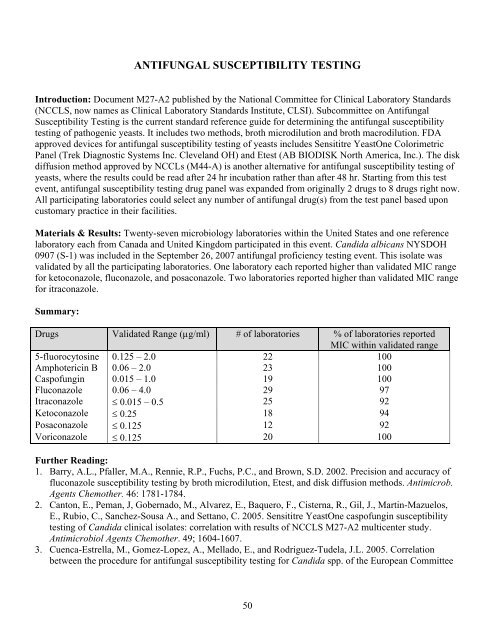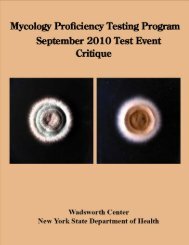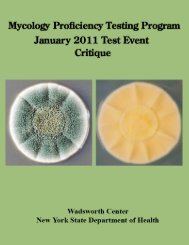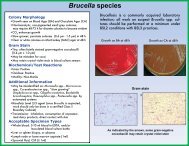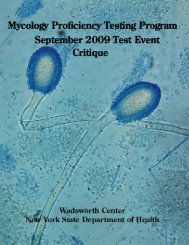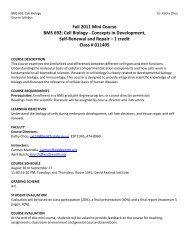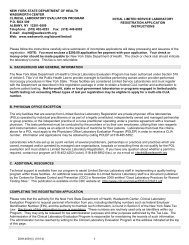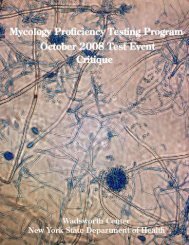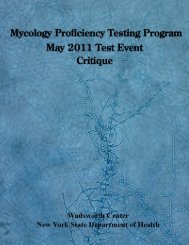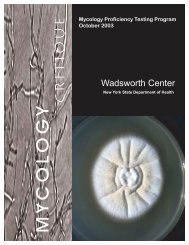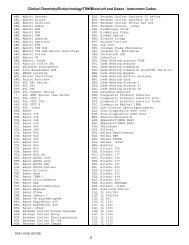September 2007 - Wadsworth Center
September 2007 - Wadsworth Center
September 2007 - Wadsworth Center
You also want an ePaper? Increase the reach of your titles
YUMPU automatically turns print PDFs into web optimized ePapers that Google loves.
ANTIFUNGAL SUSCEPTIBILITY TESTINGIntroduction: Document M27-A2 published by the National Committee for Clinical Laboratory Standards(NCCLS, now names as Clinical Laboratory Standards Institute, CLSI). Subcommittee on AntifungalSusceptibility Testing is the current standard reference guide for determining the antifungal susceptibilitytesting of pathogenic yeasts. It includes two methods, broth microdilution and broth macrodilution. FDAapproved devices for antifungal susceptibility testing of yeasts includes Sensititre YeastOne ColorimetricPanel (Trek Diagnostic Systems Inc. Cleveland OH) and Etest (AB BIODISK North America, Inc.). The diskdiffusion method approved by NCCLs (M44-A) is another alternative for antifungal susceptibility testing ofyeasts, where the results could be read after 24 hr incubation rather than after 48 hr. Starting from this testevent, antifungal susceptibility testing drug panel was expanded from originally 2 drugs to 8 drugs right now.All participating laboratories could select any number of antifungal drug(s) from the test panel based uponcustomary practice in their facilities.Materials & Results: Twenty-seven microbiology laboratories within the United States and one referencelaboratory each from Canada and United Kingdom participated in this event. Candida albicans NYSDOH0907 (S-1) was included in the <strong>September</strong> 26, <strong>2007</strong> antifungal proficiency testing event. This isolate wasvalidated by all the participating laboratories. One laboratory each reported higher than validated MIC rangefor ketoconazole, fluconazole, and posaconazole. Two laboratories reported higher than validated MIC rangefor itraconazole.Summary:Drugs Validated Range (µg/ml) # of laboratories % of laboratories reportedMIC within validated range5-fluorocytosine 0.125 – 2.0 22 100Amphotericin B 0.06 – 2.0 23 100Caspofungin 0.015 – 1.0 19 100Fluconazole 0.06 – 4.0 29 97Itraconazole ≤ 0.015 – 0.5 25 92Ketoconazole ≤ 0.25 18 94Posaconazole ≤ 0.125 12 92Voriconazole ≤ 0.125 20 100Further Reading:1. Barry, A.L., Pfaller, M.A., Rennie, R.P., Fuchs, P.C., and Brown, S.D. 2002. Precision and accuracy offluconazole susceptibility testing by broth microdilution, Etest, and disk diffusion methods. Antimicrob.Agents Chemother. 46: 1781-1784.2. Canton, E., Peman, J, Gobernado, M., Alvarez, E., Baquero, F., Cisterna, R., Gil, J., Martin-Mazuelos,E., Rubio, C., Sanchez-Sousa A., and Settano, C. 2005. Sensititre YeastOne caspofungin susceptibilitytesting of Candida clinical isolates: correlation with results of NCCLS M27-A2 multicenter study.Antimicrobiol Agents Chemother. 49; 1604-1607.3. Cuenca-Estrella, M., Gomez-Lopez, A., Mellado, E., and Rodriguez-Tudela, J.L. 2005. Correlationbetween the procedure for antifungal susceptibility testing for Candida spp. of the European Committee50


